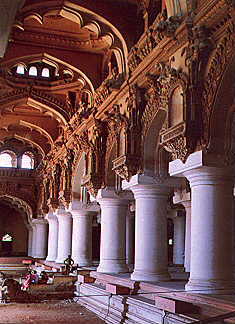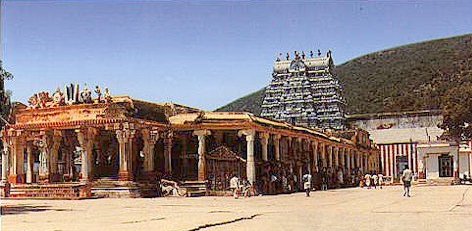|

Madurai
 It is narrated in legend that Madurai was originally a
forest known as Kadambavanam. One day, a farmer named Dhananjaya who was passing
through the forest, saw Indra (The king of the gods), worshipping a swayambhu
(self created Lingam ) under kadamba tree. Dhananjaya, the farmer immediately
reported this to King Kulasekara Pandya. Kulasekara Pandya cleared the forest
and built a temple around the Lingam. A city was soon planned with the temple as
its centre. On the day the city was to be named, Lord Shiva is said to have
appeared and drops of nectar from his hair fell on the town. So, the place was
named Madurai - mathuram meaning "sweetness" in Tamil. It is narrated in legend that Madurai was originally a
forest known as Kadambavanam. One day, a farmer named Dhananjaya who was passing
through the forest, saw Indra (The king of the gods), worshipping a swayambhu
(self created Lingam ) under kadamba tree. Dhananjaya, the farmer immediately
reported this to King Kulasekara Pandya. Kulasekara Pandya cleared the forest
and built a temple around the Lingam. A city was soon planned with the temple as
its centre. On the day the city was to be named, Lord Shiva is said to have
appeared and drops of nectar from his hair fell on the town. So, the place was
named Madurai - mathuram meaning "sweetness" in Tamil.
Madurai is surrounded by several mountains. It is famous for Jasmine
Flowers. Jasmine flowers are transported to other cities of India from
Madurai.
Madurai
city is famous for its Temples. They are known for its rich Architecture and
Sculptural works. Besides,
there are interesting places to be visited in
Madurai.
Tirumalai
Nayak Palace
 This Palace was built in
1636 by King Thirumalai Nayak with
the help of an Italian Architect. The building we see today was the main
Palace where the King lived. The original Palace Complex was four times
bigger than the present structure. This palace consisted mainly of two
parts, namely Swargavilasa and Rangavilasa. This Palace was built in
1636 by King Thirumalai Nayak with
the help of an Italian Architect. The building we see today was the main
Palace where the King lived. The original Palace Complex was four times
bigger than the present structure. This palace consisted mainly of two
parts, namely Swargavilasa and Rangavilasa.
In these two parts, there are royal residence, theatre, shrine,
apartments, armoury, palanquin place, royal bandstand, quarters, pond
and garden. King Thirumalai Nayak celebrated festivals like Sceptre
festival, Navarathri, Chithirai festival, Masi festival and the Float
festival.
He conducted daily dance and music performances in the palace. This
palace was destroyed by his grandson Chokkanatha
Nayak and the valuables were transferred to other places.
During the British rule, in 1822, Lord Nepier made several renovation works. Then the palace was utilized to house
some officials of the judiciary and district administration. After
independance, this palace was declared as a national monument and
is now under the care of the Tamilnadu Archaeological Department.
It can be visited from 9a.m to 5 p.m on payment of the entrance
fee.
Azhagar Kovil  Located 21
kms.
northwest of Madurai is a Vishnu Temple on a picturesque wooded hill. Located 21
kms.
northwest of Madurai is a Vishnu Temple on a picturesque wooded hill.
Here 'Vishnu' presides as
Meenakshi's brother 'Azhgar'. During
the Chitrai festival in April/May, when the celestial marriage of
Meenakshi to Sundareswarar is celebrated, Azhagar travels to Madurai. A
gold processional icon called the Sundararajar is carried by devotees in
procession from Azhagar Kovil to Madurai for wedding ritual.
Palamudhirsolai, one of the six abodes of Lord Subramanya is
on the same hill, about 4 kms. above. A natural spring called Nuburagangai
where pilgrims bath, is located here. Thirupparankundram
Thirupparankundram, 10 km south
of Madurai, is one of the six abodes of Lord Subramaniya.
It is a cave temple . Here Lord Muruga was wedded to
Devayanai, daughter
of Indra, after annihilating Surapadman.
In the temple there are separate shrines dedicated to Shiva,
Ganapathy, Durgai, Vishnu and other deities.
At the entrance to the temple there are 48 pillars with artistic carvings.
The Rock-cut Temple of Subramaniya here is thronged with pilgrims on all
days of special worship.
Its
innermost shrine is cut out of a solid rock.
The Meenakshi Temple
Just one Kilometer
distance from Bus stand. The Temple is dedicated to Meenakshi, the lovely
consort of Lord Shiva. The original temple was
built by Kulasekara Pandya, but the entire credit for making the temple as
splendid as it is today goes to the Nayaks. The Nayaks ruled Madurai from the
16th to the 18th century and left a majestic imprint of their rule in the
Meenakshi - Sundareswarar Temple.
Top
|



